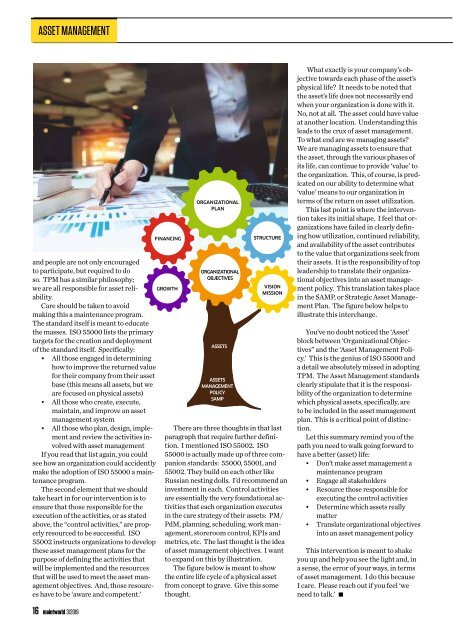Maintworld 3/2019
How Digital Twins Can Accelerate Your Digital Transformation // The Art of Reliability (and Performance) Improvement // 10 Basics to Improve Maintenance in Your Organisation
How Digital Twins Can Accelerate Your Digital Transformation // The Art of Reliability (and Performance) Improvement // 10 Basics to Improve Maintenance in Your Organisation
Create successful ePaper yourself
Turn your PDF publications into a flip-book with our unique Google optimized e-Paper software.
ASSET MANAGEMENT<br />
and people are not only encouraged<br />
to participate, but required to do<br />
so. TPM has a similar philosophy;<br />
we are all responsible for asset reliability.<br />
Care should be taken to avoid<br />
making this a maintenance program.<br />
The standard itself is meant to educate<br />
the masses. ISO 55000 lists the primary<br />
targets for the creation and deployment<br />
of the standard itself. Specifically:<br />
• All those engaged in determining<br />
how to improve the returned value<br />
for their company from their asset<br />
base (this means all assets, but we<br />
are focused on physical assets)<br />
• All those who create, execute,<br />
maintain, and improve an asset<br />
management system<br />
• All those who plan, design, implement<br />
and review the activities involved<br />
with asset management<br />
If you read that list again, you could<br />
see how an organization could accidently<br />
make the adoption of ISO 55000 a maintenance<br />
program.<br />
The second element that we should<br />
take heart in for our intervention is to<br />
ensure that those responsible for the<br />
execution of the activities, or as stated<br />
above, the “control activities,” are properly<br />
resourced to be successful. ISO<br />
55002 instructs organizations to develop<br />
these asset management plans for the<br />
purpose of defining the activities that<br />
will be implemented and the resources<br />
that will be used to meet the asset management<br />
objectives. And, those resources<br />
have to be ‘aware and competent.’<br />
FINANCING<br />
GROWTH<br />
ORGANIZATIONAL<br />
PLAN<br />
ORGANIZATIONAL<br />
OBJECTIVES<br />
ASSETS<br />
ASSETS<br />
MANAGEMENT<br />
POLICY<br />
SAMP<br />
STRUCTURE<br />
VISION<br />
MISSION<br />
There are three thoughts in that last<br />
paragraph that require further definition.<br />
I mentioned ISO 55002. ISO<br />
55000 is actually made up of three companion<br />
standards: 55000, 55001, and<br />
55002. They build on each other like<br />
Russian nesting dolls. I’d recommend an<br />
investment in each. Control activities<br />
are essentially the very foundational activities<br />
that each organization executes<br />
in the care strategy of their assets: PM/<br />
PdM, planning, scheduling, work management,<br />
storeroom control, KPIs and<br />
metrics, etc. The last thought is the idea<br />
of asset management objectives. I want<br />
to expand on this by illustration.<br />
The figure below is meant to show<br />
the entire life cycle of a physical asset<br />
from concept to grave. Give this some<br />
thought.<br />
What exactly is your company’s objective<br />
towards each phase of the asset’s<br />
physical life? It needs to be noted that<br />
the asset’s life does not necessarily end<br />
when your organization is done with it.<br />
No, not at all. The asset could have value<br />
at another location. Understanding this<br />
leads to the crux of asset management.<br />
To what end are we managing assets?<br />
We are managing assets to ensure that<br />
the asset, through the various phases of<br />
its life, can continue to provide ‘value’ to<br />
the organization. This, of course, is predicated<br />
on our ability to determine what<br />
‘value’ means to our organization in<br />
terms of the return on asset utilization.<br />
This last point is where the intervention<br />
takes its initial shape. I feel that organizations<br />
have failed in clearly defining<br />
how utilization, continued reliability,<br />
and availability of the asset contributes<br />
to the value that organizations seek from<br />
their assets. It is the responsibility of top<br />
leadership to translate their organizational<br />
objectives into an asset management<br />
policy. This translation takes place<br />
in the SAMP, or Strategic Asset Management<br />
Plan. The figure below helps to<br />
illustrate this interchange.<br />
You’ve no doubt noticed the ‘Asset’<br />
block between ‘Organizational Objectives”<br />
and the ‘Asset Management Policy.’<br />
This is the genius of ISO 55000 and<br />
a detail we absolutely missed in adopting<br />
TPM. The Asset Management standards<br />
clearly stipulate that it is the responsibility<br />
of the organization to determine<br />
which physical assets, specifically, are<br />
to be included in the asset management<br />
plan. This is a critical point of distinction.<br />
Let this summary remind you of the<br />
path you need to walk going forward to<br />
have a better (asset) life:<br />
• Don’t make asset management a<br />
maintenance program<br />
• Engage all stakeholders<br />
• Resource those responsible for<br />
executing the control activities<br />
• Determine which assets really<br />
matter<br />
• Translate organizational objectives<br />
into an asset management policy<br />
This intervention is meant to shake<br />
you up and help you see the light and, in<br />
a sense, the error of your ways, in terms<br />
of asset management. I do this because<br />
I care. Please reach out if you feel ‘we<br />
need to talk.’<br />
16 maintworld 3/<strong>2019</strong>

















